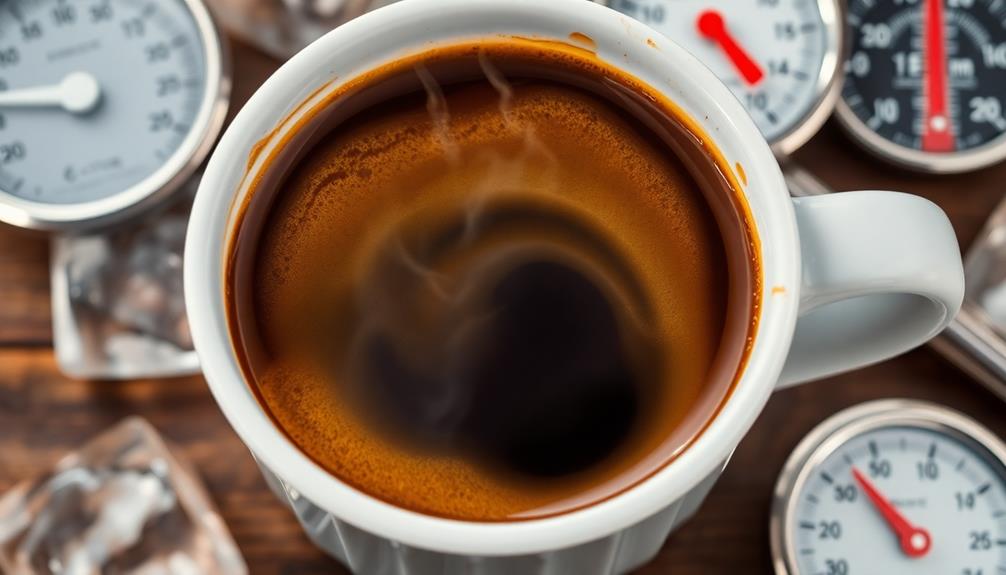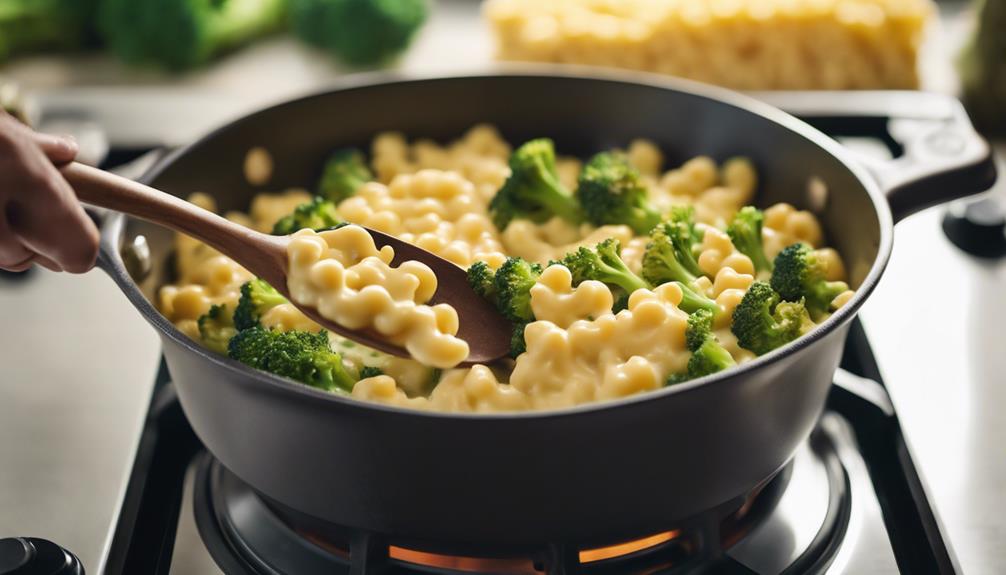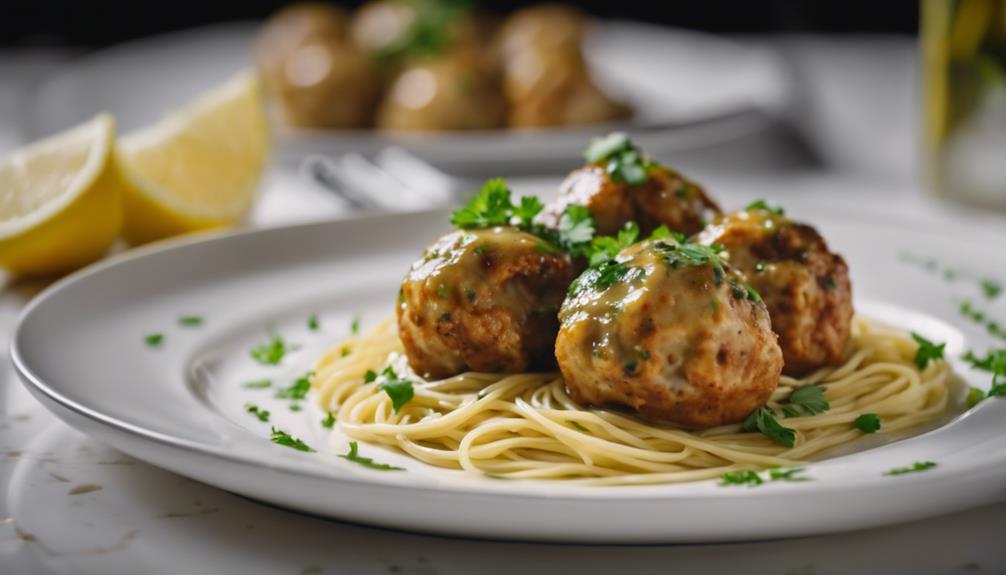Molecular gastronomy combines culinary artistry with scientific principles, allowing you to experience food in innovative ways. Techniques like spherification and foaming enhance textures and flavors, transforming traditional dishes into extraordinary experiences. With pioneering chefs like Ferran Adrià leading the charge, this movement pushes culinary boundaries and challenges how you perceive flavor and presentation. Vital tools such as sous-vide machines and siphon whips are essential for success in this field. As you explore this fascinating world, you'll discover more about its rich history and the techniques that can elevate your cooking to a whole new level.
Key Takeaways
- Molecular gastronomy merges culinary arts with food science, focusing on physical and chemical transformations during food preparation.
- Key techniques include spherification, foaming, and sous-vide, enhancing textures and presentations in innovative ways.
- Influential figures like Ferran Adrià and Elizabeth Cawdry Thomas have significantly shaped the movement since its formal introduction in 1992.
- Essential tools for molecular gastronomy include sous-vide machines, siphon whips, and precision scales to ensure accurate measurements and results.
- The discipline transforms high-end dining, encouraging unique culinary creations while emphasizing the importance of grounding techniques in solid science.
What Is Molecular Gastronomy?
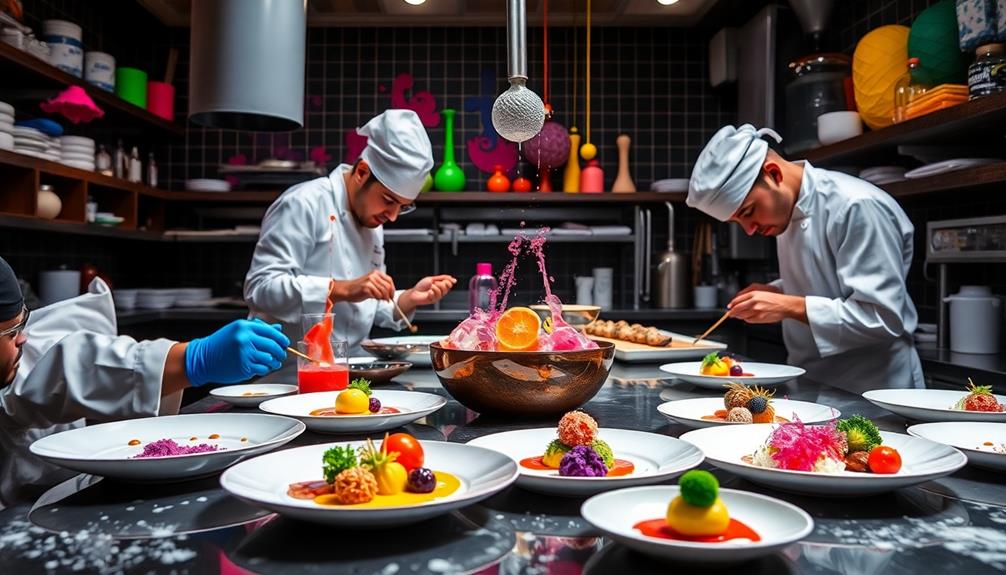
Molecular gastronomy is a fascinating culinary discipline that combines food science with innovative cooking techniques. You'll discover that this movement focuses on the physical and chemical transformations that occur during food preparation, revealing the science behind what you eat.
Introduced in 1992 during the Erice Workshops in Sicily, the term emphasizes the importance of understanding cooking processes on a molecular level. This discipline can parallel the intricate flavors of Brazilian cuisine, where diverse cultural influences and unique ingredients come together to create remarkable dishes. Chefs and scientists collaborate to deconstruct the science behind textures, aromas, and transformations, offering deeper insights into culinary innovation. This approach not only enhances traditional cuisines but also inspires new creations that push the boundaries of taste and presentation. Similarly, events like the *Florence Cocktail Week Overview* bring attention to the art and science of mixology, where precision and creativity are equally celebrated. By marrying the worlds of gastronomy and science, molecular techniques open up endless possibilities for reinvention and exploration in both food and drinks. Events such as *Florence Cocktail Week 2023* highlight how bartenders utilize similar principles to craft innovative cocktails, balancing flavors and techniques with expert precision. This fusion of scientific rigor and culinary artistry allows both chefs and mixologists to redefine the limits of what we perceive as food and drink, sparking a continued evolution of taste.
Key techniques like spherification, foaming, and sous-vide allow chefs to create unique textures and presentations, pushing the boundaries of traditional cooking. When you explore molecular gastronomy, you'll find that it challenges long-held beliefs about how food should be prepared and enjoyed.
Influential figures such as Ferran Adrià and Hervé This have considerably shaped this culinary movement, with Adrià famously pioneering the use of foams and spherification.
This discipline encourages you to experiment and dive deeper into the science of flavor and texture. By mastering these molecular techniques, you can elevate your cooking, creating dishes that not only taste incredible but also surprise and delight your guests.
Embrace the wonder of molecular gastronomy, and transform your culinary creations into unforgettable experiences.
Historical Background and Evolution

Molecular gastronomy has its roots in the innovative practices of medieval and Renaissance chefs, who began merging science with cooking.
Traditional techniques, such as slow braising, can be seen as early forms of manipulating ingredients to create profound flavors, similar to dishes like Red-Braised Pork Belly.
You'll find that key figures, like Elizabeth Cawdry Thomas, played a significant role in bringing this culinary approach to the forefront in the 1990s.
As you explore its evolution, you'll notice how early scientific methods laid the groundwork for what we now recognize as molecular gastronomy.
Origins of Molecular Gastronomy
While many culinary traditions have embraced scientific principles for centuries, the formalization of molecular gastronomy as a distinct movement began in 1992 at the Erice Workshops in Sicily, organized by Elizabeth Cawdry Thomas. This event marked a pivotal moment where chefs and scientists gathered to explore the origins of molecular gastronomy, blending culinary arts with food science.
The intersection of culinary experiences and scientific exploration is evident in various global cuisines, as seen in the rich flavors of Asian cuisine, where traditional cooking techniques often incorporate innovative approaches.
The historical roots of this movement can be traced back to medieval and Renaissance chefs who experimented with early scientific cooking techniques. Significantly, the 15th-century manuscript "The Vivendier" documents some of these daring methods, albeit with significant risks.
The invention of the pressure cooker by Denis Papin in the 17th century further laid the groundwork for understanding how pressure and heat transform food, concepts that are central to molecular gastronomy today.
As the late 20th century unfolded, advancements in food science fueled the movement, leading to a fusion of chemistry with cooking. This evolution sparked discussions about the nature of molecular gastronomy, including debates on its necessity and perceived elitism in the culinary world.
Key Influential Figures
The evolution of molecular gastronomy owes much to the influential figures who have shaped its landscape. In 1992, Elizabeth Cawdry Thomas introduced the term at the Erice Workshops in Sicily, marking a pivotal moment for the discipline. Among the key influential figures, Ferran Adrià stands out for his groundbreaking techniques at El Bulli, including foam and reverse spherification. Grant Achatz also plays a significant role, pushing boundaries with his innovative cuisine.
Dr. Harold McGee's writings provide essential scientific insights, bridging food science and culinary arts. He's influenced countless chefs and food enthusiasts, enhancing their understanding of cooking principles. Additionally, physicist Nicholas Kurti coined the term "molecular gastronomy" and collaborated with chefs to emphasize the scientific aspects of cooking. The historical contributions of chefs like Marie-Antoine Carême laid the groundwork for the artistic presentations now seen in this culinary movement.
| Influential Figure | Contribution |
|---|---|
| Elizabeth Cawdry Thomas | Introduced the term in 1992 |
| Ferran Adrià | Pioneered techniques at El Bulli |
| Grant Achatz | Innovated modern molecular cuisine |
| Dr. Harold McGee | Provided scientific insights |
| Nicholas Kurti | Coined the term and emphasized science |
Key Techniques and Innovations

In the exciting domain of culinary exploration, key techniques and innovations in molecular gastronomy revolutionize how we experience food.
One enchanting method is spherification, which transforms liquids into gel-like spheres that burst with flavor when you bite into them. For instance, imagine a tiny sphere of savory Mushroom Masala sauce exploding on your palate!
Foaming is another key technique that adds airy textures to your dishes. Using a siphon whip and emulsifiers, chefs create light, fluffy foams that enhance both mouthfeel and visual appeal. When you try a dish with foamed elements, you'll notice how it elevates the entire experience.
Sous-vide cooking, where food is vacuum-sealed and cooked at precise temperatures, guarantees that your ingredients come out perfectly tender and evenly cooked every time.
Gelification, employing gelling agents like agar-agar or gelatin, allows chefs to craft innovative textures that delight and surprise.
Lastly, creative presentation is essential in molecular gastronomy. Techniques that challenge traditional plating not only enhance the look of your meal but also elevate your overall dining experience.
Embrace these key techniques and watch how they transform your culinary adventures!
Essential Tools for Cooking
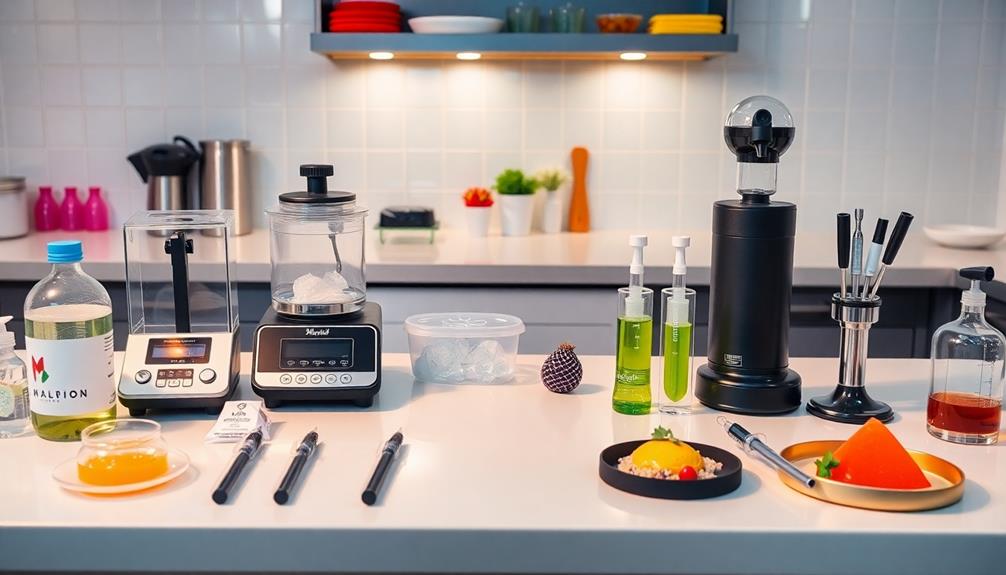
Essential tools are essential for mastering molecular gastronomy and releasing your culinary potential. In the world of molecular gastronomy, having the right equipment can make all the difference in achieving innovative and delicious results. Here's a breakdown of some essential tools for cooking that you should consider adding to your kitchen:
| Tool | Purpose |
|---|---|
| Sous-Vide Machine | Maintains precise temperature control for even cooking |
| Siphon Whip | Creates foams and espumas for innovative textures |
| Immersion Blender | Blends ingredients smoothly and makes emulsions |
| Molecular Gastronomy Kit | Contains specialized ingredients and tools for experimentation |
| Precision Scale | Measures ingredients accurately, important for strict recipes |
Influential Figures and Contributors

When you explore the world of molecular gastronomy, you'll encounter key figures who shaped its evolution.
Innovators like Ferran Adrià and Hervé This introduced groundbreaking techniques that transformed culinary practices, similar to how classic American comfort foods like the Loaded Baked Potato have evolved over time.
You'll also notice how gender dynamics play a role in the recognition of contributors within this fascinating field.
Pioneers of Molecular Gastronomy
Molecular gastronomy has been shaped by several influential figures who've pushed the boundaries of culinary art and science. One of the most notable is Ferran Adrià, whose work at El Bulli revolutionized modern cuisine with techniques like foaming and reverse spherification. His adventurous approach inspires many chefs today, including those who explore traditional dishes like Agnolotti, showcasing regional culinary skills.
Dr. Harold McGee, a respected food scientist, has greatly influenced the understanding of molecular gastronomy principles through his writings on the chemistry of cooking.
Then there's Nicholas Kurti, a physicist who coined the term "molecular gastronomy" and was among the first to advocate for a scientific study of cooking, laying essential groundwork for this culinary movement.
Hervé This, a leading chemist and co-founder of molecular gastronomy, has conducted extensive research on the scientific processes behind cooking and flavor, further enriching the field.
Finally, Grant Achatz, chef of the acclaimed restaurant Alinea, is celebrated for his innovative presentations that incorporate molecular gastronomy techniques into high-end dining experiences, making each meal a sensory adventure.
These pioneers have collectively transformed the culinary landscape, making molecular gastronomy a fascinating blend of science and art.
Key Techniques and Innovations
Key techniques and innovations in molecular gastronomy showcase the dynamic interplay between culinary creativity and scientific principles. Renowned chef Ferran Adrià revolutionized the field with pioneering methods like foam and reverse spherification, which have become staples in modern cooking. His work demonstrates how molecular gastronomy can transform textures and flavors, elevating dining experiences.
By incorporating fresh, seasonal ingredients, such as those found in farm-to-table cooking, chefs can enhance the quality and taste of innovative dishes.
Dr. Harold McGee's scientific insights into the chemistry of cooking provide foundational knowledge that supports various molecular gastronomy techniques. His research helps you understand how ingredients interact, allowing you to create dishes that surprise and delight.
Nicholas Kurti, an early advocate of molecular gastronomy, highlighted the importance of scientific inquiry in culinary practices, asserting that a deeper understanding of science could enhance cooking. Grant Achatz's Alinea takes this to heart, with its artistic presentations and innovative techniques pushing the boundaries of traditional dining.
The Erice Workshops, organized by Elizabeth Cawdry Thomas, further foster collaboration between chefs and scientists, promoting experimentation. These gatherings have been instrumental in solidifying molecular gastronomy as a legitimate and exciting culinary discipline, inspiring you to explore the endless possibilities in the kitchen.
Gender Dynamics in Recognition
Although the contributions of women in molecular gastronomy are considerable, their recognition often lags behind that of their male counterparts. You mightn't realize that women like Elizabeth Cawdry Thomas have made critical advancements in culinary science yet remain underappreciated in culinary history.
The narrative often highlights male figures, overshadowing the important roles women have played in this innovative field. For instance, the intricate techniques used in traditional Japanese cuisine, such as preparing Dorayaki (Red Bean Pancake), showcase the artistry and precision that women have historically brought to the culinary world.
Consider the early 19th-century chef Marie-Antoine Carême, who emphasized aesthetics and complexity in cooking. While he's revered, women's contributions during this period and beyond have been marginalized.
Despite being involved in key workshops and pioneering culinary innovations, gender dynamics have limited visibility for female chefs in molecular gastronomy.
Prominent male chefs like Ferran Adrià and Grant Achatz have certainly popularized this culinary movement, but it's important to recognize the women who've also contributed considerably.
As you explore this fascinating world, remember that the recognition of female chefs is evolving. A more inclusive culinary history is needed, one that acknowledges diverse influences and celebrates the contributions of all figures, regardless of gender, in shaping molecular gastronomy.
Impact on Culinary Practices
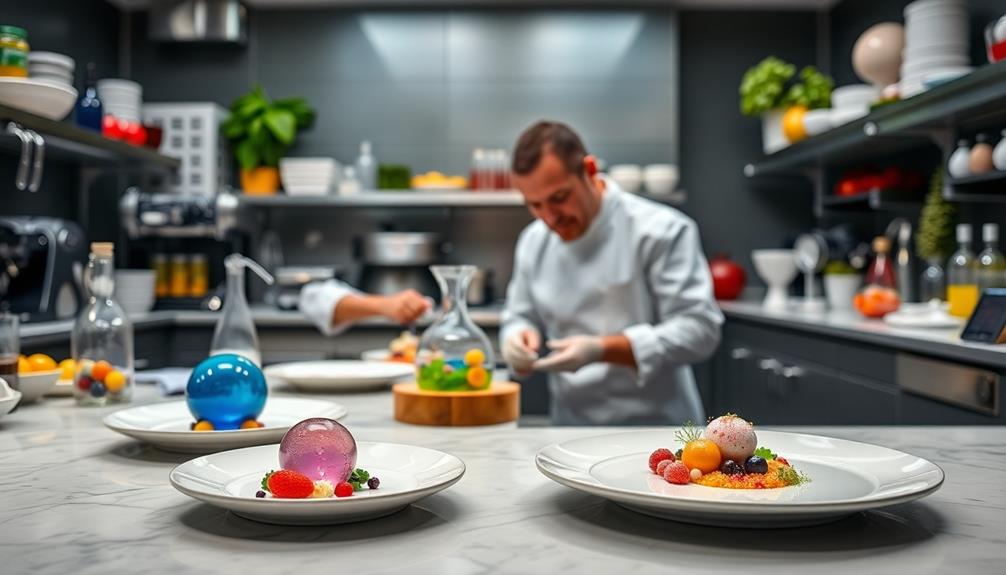
The rise of molecular gastronomy has transformed culinary practices, particularly in high-end dining establishments. Restaurants like El Bulli have pioneered innovative techniques, earning global acclaim and multiple titles as the Best Restaurant in the World.
This movement encourages you, as a chef, to explore the scientific principles of cooking, leading to unique textures and presentations that challenge traditional culinary norms. In the same way that traditional Indonesian desserts like Kue Putu showcase a unique preparation method, molecular gastronomy invites chefs to experiment with new forms and flavors.
Techniques such as spherification and sous-vide have become mainstream, enabling you to manipulate the physical and chemical properties of ingredients. This not only enhances flavor but also elevates the aesthetic appeal of dishes.
As molecular gastronomy gains traction, there's a greater interest in culinary science, resulting in educational workshops and resources that bridge the gap between chefs and food scientists.
However, critics caution against the potential misuse of these techniques, which can lead to negative perceptions. They emphasize the need to ground creative applications in solid scientific principles to maintain credibility.
Ultimately, molecular gastronomy has reshaped how you approach cooking, pushing the boundaries of what's possible in the kitchen while inviting ongoing exploration and innovation.
Exploring Flavor and Texture
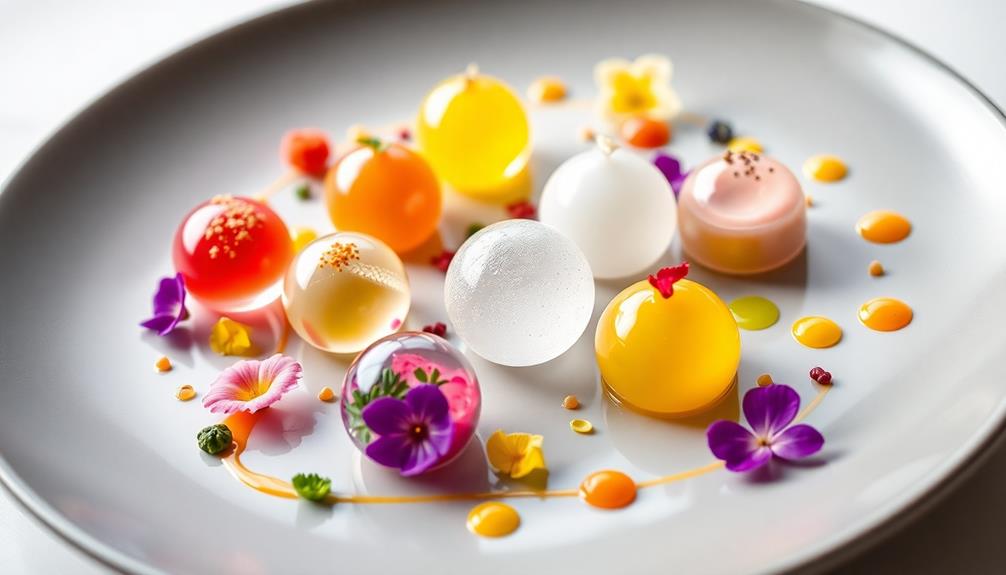
As you explore the world of molecular gastronomy, you'll discover how manipulating flavor and texture can elevate your culinary creations. This innovative approach focuses on the physical and chemical properties of food, allowing you to craft unique dining experiences.
Techniques like spherification transform liquids into gel-like spheres that burst with flavor, enhancing each bite and enchanting your guests' senses. Just as traditional Ethiopian dishes like Yekolo (Roasted Barley) showcase a unique texture and flavor, molecular gastronomy can similarly surprise and delight your palate.
Foams and espumas, created with a siphon whip and emulsifiers, introduce an airy texture that intensifies flavors from concentrated ingredients. Imagine drizzling a delicate foam over a dish, adding both visual appeal and a surprising taste sensation.
Additionally, sous-vide cooking lets you vacuum-seal food and cook it at precise temperatures, resulting in tender, flavorful dishes that maintain their integrity.
Understanding the science behind flavor perception is essential in molecular gastronomy, as factors like temperature and salt concentration can dramatically alter taste experiences. By experimenting with these elements, you can influence culinary presentations and pairings, creating a memorable meal.
Embrace the possibilities of molecular gastronomy, and watch how your dishes come alive with exciting flavors and fascinating textures.
Practical Tips for Success
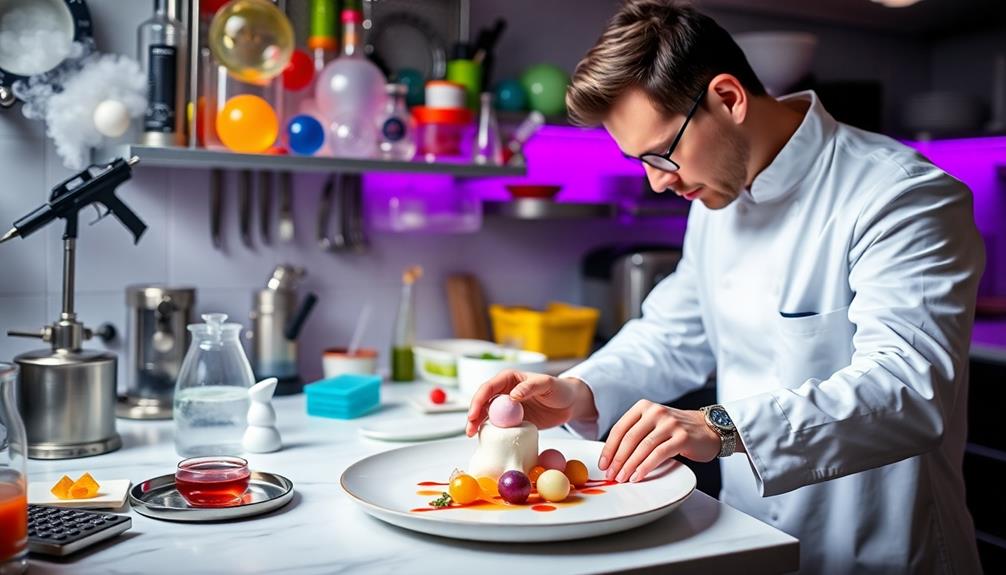
To succeed in molecular gastronomy, start with simple techniques like spherification and foaming, allowing you to build confidence and understanding before tackling more intricate methods. Follow recipes meticulously, paying close attention to precise measurements, often down to the nanogram, to guarantee successful outcomes.
Invest in essential tools like a precision scale, sous-vide machine, and siphon whip, as they're critical for achieving the desired textures and presentations in molecular gastronomy. Experiment with plating and presentation techniques to enhance the visual appeal of your dishes, since aesthetics play a significant role in the dining experience.
Practice patience and embrace the learning process; mastering molecular gastronomy requires time, experimentation, and a willingness to learn from both successes and failures.
| Key Element | Importance |
|---|---|
| Simple Techniques | Build confidence and foundational skills |
| Precise Measurements | Guarantee successful outcomes |
| Essential Tools | Achieve desired textures and presentations |
| Plating Techniques | Enhance visual appeal of dishes |
| Patience & Experimentation | Key to mastering molecular gastronomy |
Future Trends in Gastronomy
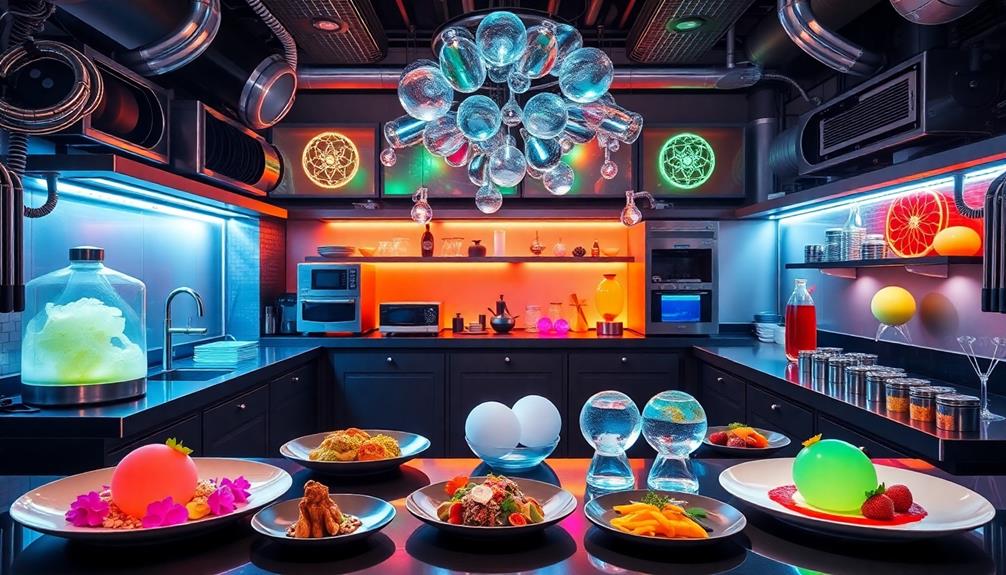
Exciting changes are on the horizon for gastronomy, with molecular techniques steadily making their way into everyday cooking.
You'll notice chefs increasingly integrating scientific methods to enhance flavor and presentation, bringing molecular gastronomy to the forefront of mainstream culinary practices.
One major trend is the rise of plant-based molecular gastronomy.
As you explore menus, expect to see innovative dishes that experiment with new textures and flavors from vegetables and alternative proteins, catering to your growing interest in sustainable dining options.
Technology is also revolutionizing meal preparation.
With advancements like 3D food printing and smart kitchen devices, you'll experience greater creativity and precision in your meals.
Moreover, the focus on sensory dining experiences is likely to grow.
Chefs are delving into the emotional and psychological effects of food presentation and flavors, enhancing your overall dining experience beyond just taste.
Frequently Asked Questions
Why Is Molecular Gastronomy Risky?
Molecular gastronomy's risky because it requires precise measurements and techniques. If you don't understand ingredient properties or follow safety protocols, you might end up with unsafe food or even face physical hazards during preparation.
What Is the Concept of Molecular Gastronomy?
Imagine a culinary laboratory where flavors dance and textures transform. Molecular gastronomy blends science and cooking, letting you explore innovative techniques like spherification and sous-vide, unveiling new dimensions in taste and presentation you never thought possible.
Who Is the Father of Molecular Gastronomy?
If you're curious about the father of molecular gastronomy, it's Hervé This. He's revolutionized culinary science, making complex concepts accessible to chefs, and his collaborations have sparked innovative techniques in cooking you might enjoy exploring.
What Chef Is Known for Molecular Gastronomy?
If you're exploring molecular gastronomy, you'll likely hear about Ferran Adrià. He's renowned for his innovative techniques, transforming traditional cooking into an extraordinary experience. His work at El Bulli changed how chefs approach food.
Conclusion
In the vibrant domain of molecular gastronomy, you're not just cooking; you're crafting an experience that tantalizes the senses. As you explore new techniques and flavors, remember that innovation is at your fingertips. Immerse yourself in this culinary adventure, where each dish is a canvas waiting for your unique touch. With a sprinkle of creativity and a dash of science, you can transform the ordinary into the extraordinary. So, what masterpiece will you create next?


